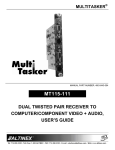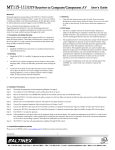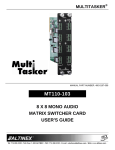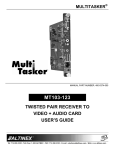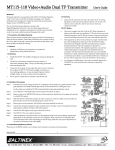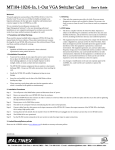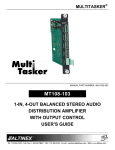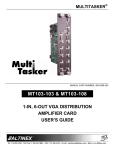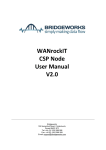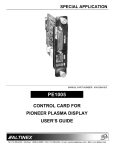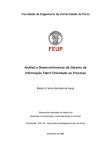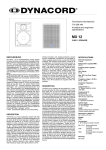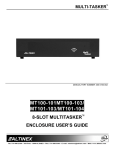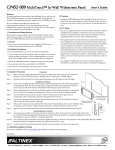Download Altinex MT115-110 Network Card User Manual
Transcript
MULTITASKER® MANUAL PART NUMBER: 400-0433-003 MT115-110 COMPUTER/COMPONENT VIDEO + AUDIO, DUAL TWISTED PAIR TRANSMITTER USER’S GUIDE MULTITASKER TABLE OF CONTENTS Page PRECAUTIONS / SAFETY WARNINGS................ 2 GENERAL..........................................................2 HANDLING ........................................................2 CLEANING.........................................................2 FCC NOTICE .....................................................2 ABOUT YOUR MT115-110....................................... 3 TECHNICAL SPECIFICATIONS.............................. 3 PRODUCT DESCRIPTION ...................................... 4 APPLICATION DIAGRAMS...................................... 5 DIAGRAM 1: TYPICAL SETUP ..........................5 DIAGRAM 2: INTERNAL VIEW ..........................6 DIAGRAM 3: SWITCH SETTINGS .....................7 INSTALLING YOUR MT115-110 ............................ 8 OPERATION ............................................................... 8 RS-232 CONTROL.............................................8 DESCRIPTION OF COMMANDS .......................9 COMMANDS..................................................9 FEEDBACK COMMANDS............................10 ID COMMANDS ...........................................13 GROUP COMMANDS..................................14 SUMMARY OF COMMANDS ...........................15 MENU MODE ...................................................16 TROUBLESHOOTING GUIDE............................... 18 LEDS ARE OFF ................................................18 DISPLAY IS TOO BRIGHT ...............................18 NO DISPLAY....................................................18 ALTINEX POLICIES ................................................ 19 LIMITED WARRANTY/RETURN POLICIES .....19 CONTACT INFORMATION ..............................19 400-0433-003 1 MULTITASKER PRECAUTIONS / SAFETY WARNINGS • 1 Please read this manual carefully before using your MT115-110 and keep it handy for future reference. These safety instructions are to ensure the long life of your MT115-110 and to prevent fire and shock hazards. Please read them carefully and heed all warnings. 1.1 GENERAL • Qualified ALTINEX service personnel or its authorized representatives must perform all service. 1.2 HANDLING • • • • Handle the MT115-110 carefully. Dropping or jarring can damage the card. The MT115-110 contains components that are sensitive to electrostatic discharge (ESD). Always use ESD safety precautions when touching the card. To prevent fire or shock, do not expose this unit to water or moisture. Do not place the MT115-110 in direct sunlight, near heaters or heat-radiating appliances, or near any liquid. Exposure to direct sunlight, smoke, or steam can harm internal components. Do not pull any cables that are attached to the MT115-110. • 1.4 CLEANING • Clean only the connector area with a dry cloth. Never use strong detergents or solvents such as alcohol or thinner. Do not use a wet cloth or water to clean the card. Do not clean or touch any component or PCB. 1.5 FCC NOTICE • This device complies with Part 15 of the FCC Rules. Operation is subject to the following two conditions: (1) This device may not cause harmful interference, and (2) this device must accept any interference received, including interference that may cause undesired operation. 400-0433-003 2 This equipment has been tested and found to comply with the limits for a Class A digital device pursuant to Part 15 of the FCC Rules. These limits are designed to provide reasonable protection against harmful interference when the equipment is operated in a commercial environment. This equipment generates, uses, and can radiate radio frequency energy and if not installed and used in accordance with the instruction manual, may cause harmful interference to radio communications. Operation of this equipment in a residential area is likely to cause harmful interference in which case the user will be required to correct the interference at his expense. Any changes or modifications to the unit not expressly approved by ALTINEX, Inc. could void the user’s authority to operate the equipment. MULTITASKER ABOUT YOUR MT115-110 2 TECHNICAL SPECIFICATIONS 3 MT115-110 Computer/Component Video+ Audio, Dual Twisted Pair Transmitter Specifications are subject to change. See www.altinex.com for up-to-date information. The MT115-110 provides a means of transmitting computer or component video and audio signals over Twisted Pair-type (CAT-5) cable when used together with an ALTINEX Twisted Pair Video Receiver, such as the MT115-111 or TP115-111. Inputs FEATURES/DESCRIPTION MT115-110 Video (2) 15-pin HD female Audio (2) 3.5 mm jack Output CAT-5/6 Twisted Pair The MT115-110 offers two 15-pin HD female inputs with native Plug & Play compatibility and two 3.5 mm audio input jacks. The RJ-45 outputs provide distributed drive to Twisted Pair cables. The MT115-110 also offers video equalization for cable lengths up to 400 ft (122 m). The equalization adjustment may be set for either hardware or software (RS-232) control. (2) RJ-45 female Table 1. MT115-110 General Additionally, the MT115-110 offers the option for video gain adjustments through RS-232 control or the gain may be set to a value of one for hardware control. MECHANICAL MT115-110 Enclosure Slots One Weight (pounds) 0.5 lbs (0.23 kg) T° Operating 10°C-35°C T° Maximum 50°C Humidity 90% non-condensing MTBF (calculations) 40,000 hrs (min.) Table 2. MT115-110 Mechanical The latest generation of Twisted Pair devices uses an innovative, patented technology* developed by ALTINEX. The new signal processing technology allows transmitting and receiving fully equalized computer video signals, stereo, and audio signals over long distances. The maximum distance at full UXGA resolution is 400 ft (122 m) between devices and may reach up to 750 ft (230 m) at VGA resolution. ELECTRICAL MT115-110 Video Input Signal Video Signal 1.5 Vp-p max Video Impedance 75 ohms SYNC Signal TTL (+/-) SYNC Impedance 10 kohms Audio Input Signal Impedance * US Patent 7,065,190 30 kohms Level 1.0 Vp-p max Twisted Pair Output CAT-5/6 Twisted Pair Video Resolution Video/Sync/Audio Signals ALTINEX Standard VGA through UXGA 480p through 1080i Power (from enclosure) +6V 0.600 A (3.6 W) -6V 0.400 A (2.4 W) Total Power Table 3. MT115-110 Electrical 400-0433-003 3 6.0 W max. MULTITASKER PRODUCT DESCRIPTION 4 TOP RETAINER SCREW AUDIO INPUT 1 RGBHV/YPbPr INPUT 1 VIDEO EQUALIZATION FOR INPUT 1 4TP OUTPUT 1 AUDIO INPUT 2 RGBHV/YPbPr INPUT 2 VIDEO EQUALIZATION FOR INPUT 2 4TP OUTPUT 2 BOTTOM RETAINER SCREW 400-0433-003 4 MULTITASKER APPLICATION DIAGRAMS 5 DIAGRAM 1: TYPICAL SETUP MT115-110 TP115-111 TP115-111 400-0433-003 5 MULTITASKER DIAGRAM 2: INTERNAL VIEW MT115-110 INPUT OUTPUT POWER EQ H/W EQ SYNC HOR PROCESSING VER VIDEO 15-PIN HD S/W SIGNAL DETECT RED PAIR 1 BLUE PAIR 3 GREEN PAIR 2 4TP PLUG and PLAY AUDIO 3.5mm LEFT Stereo to Mono RIGHT POWER S/W SIGNAL DETECT EQ H/W EQ SYNC HOR PROCESSING VER VIDEO 15-PIN HD PAIR 4 RED PAIR 1 BLUE PAIR 3 GREEN PAIR 2 PLUG and PLAY AUDIO 3.5 mm LEFT Stereo to Mono RIGHT MP 400-0433-003 PAIR 4 POWER 6 4TP MULTITASKER DIAGRAM 3: SWITCH SETTINGS SW4 EQ1 SW6 GAIN1 EQ2 GAIN2 SW3 CONTROL Video Gain Video Equalization 400-0433-003 SW5 INPUT DESCRIPTION 1 Set SW6 to SW for software control and HW for a fixed gain = 1. 2 Set SW5 to SW for software control and HW for a fixed gain = 1. 1 Set SW4 to SW for software control and HW for hardware control. 2 Set SW3 to SW for software control and HW for hardware control. 7 MULTITASKER INSTALLING YOUR MT115-110 6 OPERATION Step 1. Determine the appropriate switch settings using Diagram 3 on page 7. 7.1 RS-232 CONTROL The MT115-110 has many advanced remote-control capabilities accessible through standard RS-232 communication. Control may be accomplished through a computer control system or any other device capable of sending RS-232 communication. Step 2. Turn off power to the MultiTasker system and disconnect from AC power. Step 3. Remove a slot cover (MT200-101) from one of the unused slots. Identify the slot number and note that it is for RS-232 control. 7.1.1 RS-232 INTERFACE Step 4. Slide the MT115-110 into the enclosure in order to connect it to the bus. Make sure the card fits into place and then secure the card by tightening its retainer screws. The control commands for the MT115-110 are in a simple ASCII character format. Step 5. Restore power to the enclosure. The LEDs for each input should be on and red. Step 6. Connect the computer/component video and audio sources to Inputs 1 and 2. If a properly formatted input signal is available, the Input LED will turn green. Step 8. Connect the 4TP OUT2 to the input of its Twisted Pair receiver. is now ready Square brackets “[ ]” are part of the command. 2. Use uppercase letters for all commands. 3. Spaces are not legal characters. A command that instructs the card only to perform an action will generate feedback of “[ ]”. The open bracket immediately followed by a closed bracket indicates the card received a valid command. If the command requested information from the card, the feedback generated by the card is the acknowledgement of having received a valid command. Invalid commands generate feedback of “[ERR001]”. for Step 10. Video equalization is provided to fine-tune the displayed image on the remote display. The equalization adjustments on the MT115-110 and Twisted Pair receiver work together. Typically, for short cable runs the equalization will be set to near minimum. Cable lengths up to 400 ft (122 m) will require near maximum equalization on both units. After processing a command, an “OK” or [ERR001] will be returned as feedback if ‘F’ is included at the end of a command string. Step 11. The MT115-110 also has video gain adjustment capability through RS-232 control. See the following section for RS-232 command details. 400-0433-003 1. The cards in a MultiTasker system are capable of performing various functions, as well as providing feedback to the user or control system. Commands instruct a card to perform specific actions or request information about the status of the card. Some commands do both simultaneously. Step 7. Connect the 4TP OUT1 to the input of its Twisted Pair receiver. Step 9. The MT115-110 operation. 7 Commands ending in ‘S’ will be saved into memory. Commands not ending in ‘S’ will still be executed, but will not be restored when the system is reset or powered off, then on. 8 MULTITASKER 7.2 DESCRIPTION OF COMMANDS Each command consists of three Function, Card ID, and Unit ID. [ Function , Card ID , Unit ID ] COMMANDS parts: 1. [VER] This command displays the software version and card type for the MT115-110 card. Example: [VERC3U2] Command Format: [VERCn] VER= Function Cn = Card ID (n = slot # from 1 to max slots) C3 = Card ID or Group ID Example: U2 = Unit ID (optional for Unit ID 0) An MT115-110 card is in slot 3. Send the command [VERC3], and the system will return feedback similar to the following: For Function, see a detailed explanation under each command description. [MT115-110 690-0231-001 C03] The card ID is a unique identifier. It is equal to the enclosure slot number, or it may be an assigned value. As the slot number, the value can range from 1-4 up to 1-to-20 depending on the enclosure. If the value is assigned, the ID may be a maximum of 99. Card ID 0 (C0) is used for the controller and cannot be reassigned. MT115-110 = Model number 690-0231-001 = Firmware version C03 = Card ID 2. [C] This command displays the status of the card. The group ID is a number representing a group of cards defined with the [WR] command. When using the group ID, all cards in the group will perform the given instruction. Command Format: [Cn] NOTE: In this manual, cards will be referenced by their ID (C1, C2...C99). Typically, the ID number will be equivalent to the slot number. Groups will be referenced by their ID (G1-G8). There is an MT115-110 card in slot 3. Sending the command [C3] will yield feedback similar to the following: Cn = Card ID (n = # from 1 to max slots) Example: INPUT#1 VIDEO GAIN 4 EQUALIZATION 32 INPUT#2 VIDEO GAIN 4 EQUALIZATION 32 Changing the position of a card will significantly affect the commands recorded on software definitions or third-party control systems. The unit ID has a value from 0 to 9. Unit ID 0 should be used for single unit operation. If the unit ID is set to zero, each command may be used without Ui. Use the command [SETU0], as explained in the MT100-100 User’s Guide. In this case, both card inputs are set for a video gain of 4 and an equalization of 32. If there is no card in slot 4, sending the [C4] command will not return any feedback. Example: [VERC3]: For Unit ID Zero [VERC3Ui]: For Unit ID other than Zero [VERC3]: 400-0433-003 Equivalent to [VERC3U0] 9 MULTITASKER 3. [CnS] Example: This command saves the card settings and displays the status. After the system is reset or powered off and on, the settings are restored. A MultiTasker with unit ID 1 has a front panel with part number MT101-101 and contains an MT103-122, MT103-123, and MT115-110. Send the command [?U1] and receive the following feedback: Cn = card number S = save configuration [(MT101-101U1)(MT103-122C01) (MT103-123C02)(MT115-110C03)] Example: Save the status by sending [C4S]. The feedback returned will be similar to the following: MT101-101U1 MT103-122C01 MT103-123C02 MT115-110C03 INPUT#1 VIDEO GAIN 4 EQUALIZATION 32 INPUT#2 VIDEO GAIN 4 EQUALIZATION 32 SAVED 5. [?C] This command will return general information about the card and its status. FEEDBACK COMMANDS Command Format: [?Cn] The next four commands are a function of both the card and the front panel and are only available with MultiTasker Front Panel systems that have the following firmware: 690-0122-015 690-0123-004 690-0124-018 = Panel Number and Unit ID = An MT103-122 is in slot 1 = An MT103-123 is in slot 2 = An MT115-110 is in slot 3 Cn = Card ID (n = # from 1 to max slots) Example: The MT115-110 in slot 3 has Input 1 connected to all outputs. Each input is set to a gain level of 4 and an equalization value of 32. Send the command [?C3] and receive feedback similar to the following. = Version 015 or later. = Version 004 or later. = Version 018 or later. Send the command [VER], and the system will respond with feedback that includes the following: [(MT115-110C03)(VR690-0231-001C03) (GN0404C03)(EQ3232C03)] All status feedback is enclosed in brackets, “[ ]“. Each data field within the status is enclosed in parentheses. The first two characters identify the status type. The last three characters are the card’s ID. 690-0122-015 690-0123-004 690-0124-018 Check the last three digits against the numbers above to determine if the option is available. 4. [?] MT115-110 VR690-0231-001 GN0404 EQ3232 This command will return general information about the MultiTasker and cards installed in the unit. Command Format: [?Ui] = Card model number = Firmware version = Gain levels = Equalization values The gain and equalization settings are read from left to right. The first 2 digits are for Input 1 and the last 2 digits are for Input 2. Ui = Unit ID (i = from 0 to 9) In this case, both gains are set to 4 and both equalization levels are set to 32. 400-0433-003 10 MULTITASKER 6. [STA1] 9. [TEST] This command enables automatic feedback from the front panel. The command affects any card with auto-feedback capability, not just the MT115-110. The default at power on or reset is STA0, off. For more details, see the [?Cn] command definition. This command performs a series of tests on the internal memory and displays a pass message if successful. Otherwise, failures are indicated. Command Format: [STA1] Upon completion, the system will display the results. This feedback will be similar to the following: Command Format: [TESTCn] Cn = Card ID (n = slot # from 1 to max slots) Feedback Prefix Definitions: MT Card model number VR Firmware revision GN Gain levels EQ Equalization value MEMORY IC TEST RESULTS: MEMORY IC PASS 10. [EQ] This command displays the equalization setting for an input and selects that input for adjustment using the [+] and [-] commands. Example 1: Command = [GAIN1=10C3] Feedback = (GN1004C03) GN = Gain 1004 = Levels (IN1=10, IN2= 04) C04 = Card/Slot number 7. [STA0] This command disables automatic from the card and front panel. The affects any card with auto-feedback not just the MT115-110 card. The power on or reset is STA0, OFF. Command Format: [EQmCn] m = Input # (m = 1 or 2) Cn = Card ID (n = slot # from 1 to max slots) Example: feedback command capability, default at Display the equalization setting for Input 1 of C3, then increase the equalization level by 3 from a starting value of 12. Send the command [EQ1C3] and the current setting for Input 1 will be displayed. Command Format: [STA0] 8. [CLR] [12] This command clears the card settings and returns it to the factory default values. The default gain settings are 4 and the default equalization settings are 32 for each input. Next, send the commands [+], [+], and [+] to increase the setting by 3. Send the [EQ] command again to receive new value. [15] Command Format: [CLRCn] 11. [EQ=] Cn = Card ID (n = slot # from 1 to max slots) Example: This command sets the equalization for an input to a value specified by the user. In order to clear the card in slot 3, send the command [CLRC3]. The card will respond with the following feedback when complete: Command Format: [EQm=xCn] m = Input # (m = 1 or 2) FACTORY RESET COMPLETED x = Equalization level (x = # from 1 to 64) Cn = Card ID (n = slot # from 1 to max slots) 400-0433-003 11 MULTITASKER 14. [HELP] Example: Set the equalization on Input 2 of C3 to a value of 32 by sending the command [EQ2=32C3]. The card will respond with feedback of “[ ]” once the command is executed. This command displays information available for the MultiTasker interface commands. Command Format: [HELPCn] Cn = Card ID (n = # from 1 to max slots) 12. [GAIN] Example: This command displays the gain setting for an input and selects that input for adjustment using the [+] and [-] commands. A gain setting of 4 is equivalent to unity gain. In order to display the RS-232 commands available for the MT115-110 card in slot 3, send the command [HELPC3]. The commands along with a brief description will be displayed in the Terminal Window. Command Format: [GAINmCn] m = Input # (m = 1 or 2) 15. [...S] Cn = Card ID (n = slot # from 1 to max slots) This command will save the configuration command being sent in memory. When sending the command [EQ1=16C3S], after reset or power-up, the equalization for Input 1 will be set to 16. Example: Display the gain setting for Input 2 of C3, then decrease the gain level by 3 from a starting value of 10. 16. [FBD] Send the command [GAIN2C3] and the current setting for Input 1 will be displayed. Next, send the commands [-], [-], and [-] to decrease the setting by 3. Send the [GAIN] command again to display the new value. This command turns feedback delay on or off. It is necessary when installing some newer cards in older systems. If the system does not receive all of the feedback from the card, the card may be communicating too fast. This command will slow down the card's communication rate. [7] Command Format: [FBDm] [10] 13. [GAIN=] m This command sets the gain level for an input to a value specified by the user. A gain setting of 4 is equivalent to unity gain. Example: The command [HELPC3] is sent to the card in slot 3. Some of the HELP file is displayed on the screen, but most is missing. Send the command [FBD1] to slow down the rate at which the card sends feedback to the system. Command Format: [GAINm=xCn] m = Input # (m = 1 or 2) x = Gain level (m = # from 1 to 11, 4=unity) Cn = Card ID (n = slot # from 1 to max slots) Example: Set the gain level for Input 2 of C3 to a value of 4 by sending the command [GAIN2=4C3]. The card will respond with feedback of “[ ]” once the command is executed. 400-0433-003 = Delay (0= no delay, 1= delay 100mS) 12 MULTITASKER 17. [RSI] ID COMMANDS This command resets the card IDs in the system. After sending this command, each card ID in the system will match the slot number of the card. If the card is moved to another slot, its ID number will be the new slot number. The default card ID is the same as the card slot number. The next several commands allow the user to change the card ID to a value other than the slot number. Once the ID is changed, moving the card to another slot will not change the card ID. If a card in slot 4 is set to ID 1, then moved to slot 10, its ID will remain 1. The RSI command forces each installed card to take its slot number as its ID number, regardless of the slot in which it is installed. Command Format: [RSI] Example: Send the command [RSI] to the system with Unit ID 0. The card in slot 1 will have ID 1, the card in slot 2 will have ID 2, and so on. If the card in slot 1 is then moved to slot 4, the card ID will then be 4. Some cards require more than one slot in the MultiTasker system. As an example, some matrix switcher cards require 4 slots. If 5 of these cards are installed, they would be numbered C4, C8, C12, C16, and C20. Changing the ID allows the user to define the cards as C1, C2, C3, C4, and C5. 18. [SIDn] This command sets all the cards installed in the MultiTasker system to the same card ID. After sending this command, all cards will be addressed with the same ID. Use caution when sending this command to a system with multiple board types. Another use for changing the card ID is to be able to use multiple systems without having to set each unit to a different unit ID. All systems may be left as unit ID 0 for ease of programming. The cards in the first unit may be numbered 1-10 and in the second unit 11-20. Command Format: [SIDn] n Example: The ID commands work with all MultiTasker systems. However, front panels that have firmware releases prior to the following will not be able to address card IDs greater than the number of slots in the system: Send the command [SID1] to the system. All the cards in the system now have ID 1. Any commands that are sent to card ID 1 will be received and executed by each card. 690-0122-019 = Version 019 or later. 19. [SIDnCi] 690-0123-005 = Version 005 or later. This command sets the card ID of a single card to a number from 1 to 99. 690-0124-019 = Version 019 or later. Command Format: [SIDnCi] Send the command [VER], and the system will respond with feedback that includes the following: n = Card ID (n = # from 1 to 99) Ci = Slot Number (i = # from 1 to max slots) 690-0122-019 690-0123-005 690-0124-019 Example: Check the last three digits against the numbers above to determine if the card ID commands can address all 99 card IDs. 400-0433-003 = Card ID (n = # from 1 to 99) Send the command [SID50C10] to set the ID of the card in slot 10 to an ID of 50. 13 MULTITASKER 20. [SID+] GROUP COMMANDS This command sets the card ID of all the cards in a system to their slot number plus the offset value. The next few commands are group commands. The use of groups allows several cards with the same functions to be controlled simultaneously using a single command. Up to 8 groups (G1-G8) may be defined in a MultiTasker system. These commands apply to all cards, not only the MT115-110. Command Format: [SID+n] n = Offset amount (n = # from 0 to 99) The maximum card ID is 99, so subtract the highest slot number from 99 to find the maximum offset. For example, in an 8-slot enclosure, the maximum offset would be 91. The slot number (8) plus the offset (91) equals 99. 22. [WR] This command adds cards to a group allowing all the group members to be controlled simultaneously with the same commands. Each MultiTasker unit may define a maximum of eight groups. Example: There are two 20-slot enclosures to be connected together during normal operation. The first unit will use the default IDs where the card ID is equal to the slot number. The second unit will have the same unit ID, but each card ID will be offset by 20. In MultiTasker systems with audio and video cards, the groups are typically as follows: Group 1 = Video Cards Group 2 = Audio Cards Connect the computer to the second unit only. Send [SID+20] to set the ID of all the cards in the second enclosure to their slot number plus 20. Reconnect both units to the computer. Group 3 = Video and Audio Cards The cards in the first unit will be referenced as card IDs 1-20 and the cards in the second unit will be referenced by card IDs 21-40. Gk = Group number (k = # from 1-8) Command Format: [WRCn1Cn2…Gk] Cn = Card ID (n = slot # from 1 to max slots) Example: Add C2, C4, and C6 to G5 by sending the command [WRC2C4C6G5]. After executing this command, C2, C4, and C6 will be G5. The system will return the following feedback: 21. [RSN] This command displays the slot number of a card with a specified ID number. If more than one card has the same ID, each slot number will be displayed. [G5=C2C4C6] Now when a command is sent to G5, each board in G5 will execute the same command. Command Format: [RSNCi] Ci = Card ID (i = # from 1 to 99) 23. [RMC] Example: This command may be used to remove one or more group members from a group. Reset the system after using this command for all changes to take effect. The card in slot 4 takes up four slots in the enclosure. Its ID was set to 1 since it is the first card installed in the system, reading from left to right. Send the command [RSNC1] to find the slot number of this card. The system responds with the following feedback: Command Format: [RMCn1Cn2…Gk] Cn = Card ID (n= # from 1 to max slots) Gk = Group ID (k = # from 1-8) [4] 400-0433-003 14 MULTITASKER Example: Command Format: [RDGk] G5 consists of the C2, C4, and C6. Remove only C4 and C6 from the group by sending the command [RMC4C6G5]. The system will return the following feedback: Gk = Group ID (k = # from 1-8) Example: C2, C4, and C6 make up G5. Read the member data for G5 by sending the command [RDG5]. The system will return feedback as follows: [G5=C2] 24. [RMG] [G5=C2C4C6] This command may be used to delete an entire group, or all groups. The feedback shows G5 and then the cards that make up G5. In this case, G5 includes C2, C4, and C6. REMOVE A GROUP 7.3 SUMMARY OF COMMANDS Remove all the members from the group, effectively deleting the group. Card Commands Command Format: [RMGk] 1) [VER] Display firmware version 2) [C] Display card status 3) [CnS] Save card settings 4) [?] Display system status 5) [?C] Display card status 6) [STA1] Enable auto feedback [G5=0] 7) [STA0] Disable auto feedback REMOVE ALL GROUPS 8) [CLR] Reset card to defaults Remove all the members from every group, effectively deleting all groups. 9) [TEST] Test memory ICs Gk = Group ID (k = # from 1-8) Example: G5 consists of the C2, C4, and C6. Remove all cards from the group by sending the command [RMG5]. The system will return the following feedback: Command Format: [RMG*] Example: G5 consists of C2, C4, and C6. G2 consists of C1, C2, C3, C4, and C5. Delete all the groups by sending the command [RMG*]. The system will return the following feedback: G1-G8: EMPTY 25. [RD] 10) [EQ] Display/select equalization 11) [EQ=] Set equalization level 12) [GAIN] Display/select video gain 13) [GAIN=] Set video gain level 14) [HELP] Display available commands 15) [...S] Save command setting 16) [FBD] Enable/disable feedback delay ID Commands This command reads and then displays the members in a group. 17) [RSI] Reset Card IDs 18) [SIDn] Set all Card IDs 19) [SIDnCi] Set one Card ID 400-0433-003 15 20) [SID+n] Set Card ID offset 21) [RSN] Read Card slot number MULTITASKER Group Commands 22) [WR] 7.4.2 USING MENU MODE Group multiple cards 24) [RMG] Delete group TIP: It is best to disable the automatic feedback feature, [STA0]. The automatic feature will display after each setting change making the menus difficult to read. 25) [RD] 1. In order to enter Menu Mode, the system needs to be connected to a computer running RS-232 control software. 2. In the Terminal Window, press ENTER on the keyboard. 3. The system interrogates all cards and returns a list of cards and their ID numbers. 23) [RMC] Remove members from group Display group members 7.4 MENU MODE Menu Mode commands allow virtually the same functionality as programming commands. Unlike the programming commands in the previous sections, menu commands prompt the user to select from a list of available options. The system then responds based upon selections made by the user. Example: 08: MT115-110 NOTE: Only cards supporting the menu feature will be displayed. The menu-driven commands are only available with MultiTasker systems that have the following front panel firmware: 4. 690-0122-015 = Version 015 or later. 690-0123-004 = Version 004 or later. 690-0124-018 = Version 018 or later. WARNING: Do NOT enter any characters except those relating to the desired menu. Press ENTER after “08” and the original prompt will be displayed. Send the command [VER] and the system will respond with feedback that includes the following: 690-0122-015 690-0123-004 690-0124-018 Check the last three digits against the numbers above to determine if Menu Mode is available. 5. The system will prompt for selections specific to the selected card. 6. Read each menu carefully, and continue selecting keys as prompted for further functions. (Example prompt: "Key= ") 7.4.1 MENU COMMAND DEFINITIONS Refer to section 7.2 for details on card functions and examples. Following is a cross-reference between menu mode and programming commands. MENU Equalization Gain Save Reset Version Status Help 400-0433-003 Enter the 2-digit ID and a menu for the card will be displayed. In the example above, enter “08” for the MT115-110. 7.4.3 MENU TYPES 1. MAIN MENU The first menu displayed after selecting the card is the Main Menu. This menu provides access to the key functions related to the card. Press the key representing the menu item for access and a sub-menu will appear. COMMAND [EQ] [GAIN] [CnS] [CLR] [VER] [C] [HELP] 2. SUB-MENUS Each menu item will display either a sub-menu, or a list of options. Press the key corresponding to the desired choice. 16 MULTITASKER 7.4.4 MT115-110 MENUS 2: GAIN CONTROL GAIN CONTROL 1: INPUT#1 12 GAIN CONTROL INPUT#1 (12) 1: INCREASE GAIN LEVEL 2: DECREASE GAIN LEVEL ESC: GO BACK 2: INPUT#2 9 GAIN CONTROL INPUT#2 (9) 1: INCREASE GAIN LEVEL 2: DECREASE GAIN LEVEL ESC: GO BACK ESC: GO BACK 3: SAVE CONFIGURATION SAVE CURRENT CONFIGURATION? 1: YES 2: NO ESC: GO BACK 4: RESET CONFIGURATION TO DEFAULT RESET CARD TO FACTORY DEFAULT? 1: YES 2: NO ESC: GO BACK 5: VERSION This selection displays the card firmware version and then redisplays the Main Menu. It is equivalent to the [VER] command. Following are the menus available to the MT115-110. The first menu is the Main Menu only. The second listing is an expanded view of the card’s sub-menus. The expanded menu contains values that indicate the current setting or value of a parameter. The value is usually in parentheses, or otherwise indicated at the top of a sub-menu. In some cases, additional comments are provided for clarification and are not part of the menu feedback. MT115-110 MAIN MENU 1: EQUALIZATION CONTROL 2: GAIN CONTROL 3: SAVE CONFIGURATION 4: RESET CONFIGURATION TO DEFAULT 5: VERSION 6: STATUS 7: HELP ESC: GO BACK KEY= MT115-110 EXPANDED MENUS 1: EQUALIZATION CONTROL EQUALIZATION CONTROL 1: INPUT#1 1 EQUALIZATION CONTROL INPUT#1 (1) 1: INCREASE EQ LEVEL 2: DECREASE EQ LEVEL ESC: GO BACK 2: INPUT#2 8 EQUALIZATION CONTROL INPUT#2 (8) 1: INCREASE EQ LEVEL 2: DECREASE EQ LEVEL ESC: GO BACK ESC: GO BACK 400-0433-003 6: STATUS This selection displays the card status and then redisplays the Main Menu. It is equivalent to the [Cn] command. 7: HELP This selection displays a list of commands available for the MT115-110 along with a brief description. It is equivalent to the [HELP] command. ESC This selection returns you to the parent menu with the listing of all cards. 17 MULTITASKER 7.4.5 MENU MODE EXAMPLES TROUBLESHOOTING GUIDE All Menu Mode examples assume an MT115-110 is installed in slot 3. Start by clicking the mouse in the Terminal Window. Press ENTER and a list of available cards will be displayed. 8 We have carefully tested and found no problems in the supplied MT115-110 unit. However, we would like to offer the following suggestions: 8.1 LEDs ARE OFF Cause 1: 1. Set Video Equalization There is no power to the card. Follow the keystrokes below to set the video equalization for Input 1 to 16 with a starting level of 12. Solution 1: Make sure the card is plugged all the way into the enclosure. If an LED is still not on, see Cause 2. Enter 03 1 Cause 2: 1 1111 ESC ESC List available cards Select MT115-110 in slot 3 Select EQUALIZATION CONTROL The current gain level will be displayed in the menu, for example 12. Select INPUT #1 for adjustment Select increment 4 times After each increase, the new level will be displayed in the menu. Return to EQUALIZATION Menu Return to the Main Menu Solution 1: Turn the system power off and then back on again. If one of the LEDs is still not on, please call ALTINEX at (714) 990-2300. 8.2 DISPLAY IS TOO BRIGHT Cause 1: The software gain is too high. Solution: Set the gain control to 1 using the RS-232 commands in Section 7.2. If the display is still too bright, see Cause 2. Cause 2: The gain switch is not set correctly. Solution: Set the gain control switch to the HW (hardware) position for a fixed gain of one. If the display is still too bright, see Cause 3. Cause 3: The receiver video gain is too high. Solution: Set the gain control switch to the HW (hardware) position for a fixed gain of one. If the display is still too bright, please call ALTINEX at (714) 990-2300. 2. Display Card Status Starting from the MT115-110’s Main Menu, follow the keystrokes below. 6 Display card status NOTE: The status will be displayed, followed by the Main Menu being redisplayed. The card is not initialized. 8.3 NO DISPLAY 400-0433-003 18 Cause 1: The source has a problem. Solution: Check the source and make sure that there is a signal present and all source connections are correct. If the source is working and there is still no display, see Cause 2. MULTITASKER Cause 2: Signal is bad or missing. ALTINEX POLICIES Solution 1: Make sure the output is connected to the TP receiver. If there is still no display, see Solution 2. 9.1 LIMITED WARRANTY/RETURN POLICIES Please see the ALTINEX website at www.altinex.com for details on warranty and return policies. Solution 2: Bypass the MT115-110 and TP receiver and connect the output of the source directly to the monitor. If the display is good, then call ALTINEX at (714) 990-2300. If there is still no display, see Cause 3. Cause 3: Cable connections are incorrect. Solution: Make sure the cables are properly connected. Also, make sure that the continuity and wiring are good. If there is still no display present, see Cause 4. Cause 4: The display has a problem. Solution: Make sure the display has power applied and is turned on. If there is still no display, please call ALTINEX at (714) 990-2300. 400-0433-003 9 9.2 CONTACT INFORMATION ALTINEX, Inc. 592 Apollo Street Brea, CA 92821 USA TEL: 714 990-2300 TOLL FREE: 1-800-ALTINEX WEB: www.altinex.com E-MAIL: [email protected] 19




















